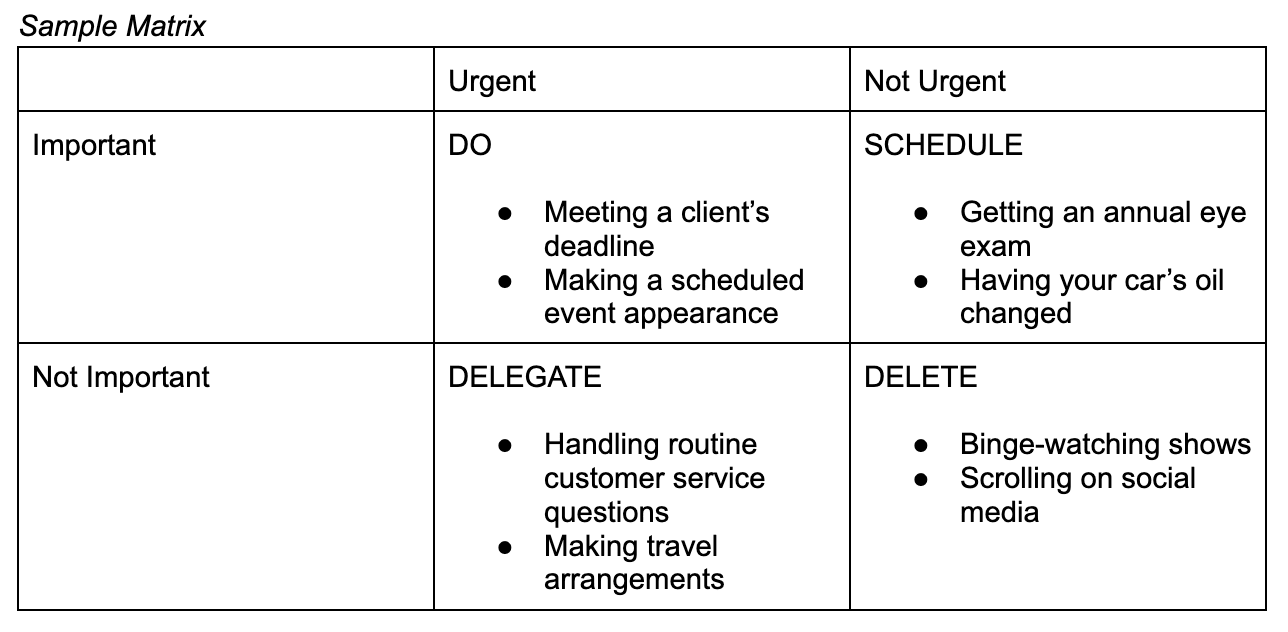If you’re looking to get more meaningful work done this year, then you’re in the right place. I’ve tried every productivity hack out there, and through this process I’ve learned that the best productivity hack of all is choosing what to work on and when to work on it. Getting good at this involves developing two skills: saying “no” more often and relative selection. Relative selection is how you compare two or more alternatives and choose what to do. If you can consistently show you have the ability to choose wisely among alternatives you will be valuable to any employer. A great way I have found to help me prioritize better is The Eisenhower Matrix, and it could be your key to maximizing your most precious resource: your time.
What is the Eisenhower Matrix?
The Eisenhower Matrix, or Eisenhower Box, is a simple decision-making tool developed and championed by former president and military general Dwight D. Eisenhower. It helps you take inventory of and classify the activities you engage in or have to complete. That way, you get a clear picture of what’s moving the needle towards your goals — and what’s wasting your time.
The Four Quadrants of the Box
The Eisenhower Box is broken into four quadrants:
- Urgent and important
- Important but not urgent
- Urgent but not important
- Not urgent or important
Urgent and Important
Urgent and important tasks are high-stakes and time-sensitive. Therefore, they should take priority and get handled personally. Examples include completing a major client project by the deadline or making a scheduled appearance at an event.
Important but Not Urgent
Important but not urgent tasks need to be taken care of at some point, but you can do them at your convenience. Examples include getting an annual eye exam or changing your car's oil.
Urgent but Not Important
Urgent but not important tasks are also time-sensitive. However, since they don’t require your expertise or involvement, they’re perfect for delegating to someone else. Examples include handling routine customer inquiries or making travel arrangements.
Not Urgent or Important
Non-urgent and unimportant activities generally don’t add value and are unnecessary drains on your time. Therefore, you should consider cutting them from your life. Examples include binge-watching shows online or scrolling mindlessly on social media.
How to Use the Matrix
To try the Eisenhower Matrix, follow these steps:
Join The Break Community
- Identify and reflect on your values, priorities, and goals (personal, professional, or both).
- Write down everything you do (or plan to do) daily, weekly, and monthly (without judgment). For extra insight, consider tracking how long each task takes you.
- Assign each activity to a quadrant in the matrix.
- Assign more of your time to activities in the top half
Reminder: While it may be tempting, don’t skip step one. When you keep your values, priorities, and goals in mind during this exercise, you’ll be able to classify each activity with ease and clarity.

I run through this exercise quarterly to balance my existing priorities with any new opportunities I’ve come across. Doing so helps me see which projects I should pursue over the next few months. It also allows me to spot the activities that get in the way of my productivity so I can decide whether to delegate or delete them.
Pro Tip: Consider filling in two matrices — one for your professional life and one for your personal life. That way, it might be easier to keep track of all of your different objectives.
Pros and Cons of Using the Matrix
Like any tool or hack, the Eisenhower Matrix has pros and cons. Arguably, the biggest perk of using it is that it helps you focus on what really matters to you in this season of your life. You can hone in on what adds the most value, delegating or deleting the tasks that don’t support the achievement of your primary goals.
But, using the tool could also cause some growing pains. That’s because if you’re like many people, you may find comfort in completing those unnecessary activities. After all, they’re easy or familiar and letting them go forces you to shift from being busy to being effective. Ultimately, the Eisenhower Box can give you the space you need to tackle your most significant and challenging work.
The Biggest Hang Ups and What to Do
By far people get tripped up the most in the “Important but not urgent” and “urgent but not important” quadrants.
Remember the entire purpose of this exercise is for you to do more of what you are uniquely good at or is most valuable for your time.
Important but not urgent
The trap here is never making time for these activities because there is no time bound urgency. The biggest casualty is investing in yourself to create more valuable skills.
Here, it’s important for you to design your life in a way that accommodates these highly important tasks. For example, when I need to be in research mode, I create “Red Phone Time” on my calendar. This means that I am unreachable by my team or family except for extremely important issues. I use RPT about 4 hours per week.
Urgent but not important
The trap here is that you get a bunch of time bound tasks that feel good to check off the list, but don’t advance your work very much. Not everyone can delegate these things to someone else, but creating and building the system by which you minimize these types of tasks becomes a highly important and urgent task for you to add to your matrix. I’ve fortunately been able to utilize employees as our business has grown for these tasks, but I have also employed VA’s and other service providers as well. Spending money in this quadrant (in my opinion) has perhaps the highest ROI of any spend, and it can unlock valuable time for you to focus and get great work done in other areas of your life.
Best Practices to Follow
Here are a few tips and tricks for getting the most out of the Eisenhower Matrix:
- Color code the quadrants to make it easy to see what you should be doing — and what you should stop doing. For example, the urgent and important section could be green, and the not urgent or important section could be red.
- Limit the number of items you put into each quadrant. That way, your workload (and the workload of your team) stays manageable.
- Allow for leisure. While activities like scrolling through your social media quadrant likely belong in the not urgent or important quadrant, you don’t have to cut them out from your life completely — especially if you get enjoyment out of doing them.
Reminder: The Eisenhower Matrix can help you take control of your life and make the most out of the time you have. But, you don’t have to be productive every waking hour. In fact, you should rest, relax, and let loose regularly. And, remember — a moment enjoyed isn’t wasted.
Final Thoughts
The Eisenhower Matrix is a straightforward but powerful way to distill your never-ending to-do list into a strategic action plan that will supercharge your productivity. It’s helped me to take great strides in my business. But, like any other system or tool, it isn’t necessarily for everyone — and that’s okay! We all have to find the best way for ourselves.
Tell me: Have you tried the Eisenhower Box exercise? If so, did you find it valuable?













